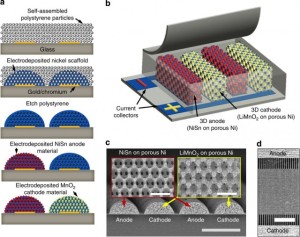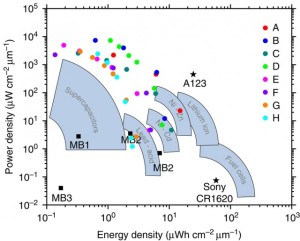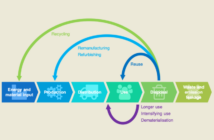Here come the new lithium-ion microbatteries with Power Density that is 2,000 times greater than the Sony CR1620 button cell. A rechargeable battery that can charge up to 1,000 times faster than conventional Li-on battery is the latest in battery innovation. Yes, a microscale lithium-ion battery with superior performance has already been developed. It is called the “University of Illinois battery” and it is considered to be the most powerful microbatteries ever documented.
About the Research
On April 16, 2013, a paper entitled “High-power lithium ion microbatteries from interdigitated three-dimensional bicontinuous nanoporous electrodes” was published in Nature Communications by researchers from the University of Illinois. According to the researchers, “It’s a new enabling technology. It’s not a progressive improvement over previous technologies; it breaks the normal paradigms of energy sources. It’s allowing us to do different, new things.” This surprising development in batteries overcomes the trade-offs between power and energy which are present on many of today’s battery technologies such as the Li-on and fuel cells.
What’s in this Microtechnology?
Researchers were able to develop very small three-dimensional nanoporous anode and cathode microstructures. From a glass substrate, they built a polystyrene (Styrofoam) structure. Nickel was then electrodeposited onto the polystyrene. Electrodeposition of nickel-tin was also performed on the anode surface, and of manganese dioxide on the cathode surface. This process resulted in having porous electrodes with massive surface areas. This new feature of electrodes enables the occurrence of more chemical reactions, which in turn gives massive boost to discharging and charging speed.
Here is the schematic of the design and fabrication process of the University of Illinois battery.
Design and Fabrication Process of University of Illinois Battery
Image Source: Actual Study Published on Nature Communications Website
Here is the graph showing the Power Density versus Energy Density of the microbattery (labeled A123) compared to various energy storage devices.
Power Density vs. Energy Density Graph of A123 Compared to Various Battery Technologies
Image Source: Nature Communications Website
Note that when it comes to Energy Density, A123’s performance is closer to that of lithium-ion and fuel cells. On Power Density, the performance is almost the same as that of supercapacitors. Overall, the University of Illinois’ new microstructured anode/cathode Li-on battery really has superior performance on the measures of both power and energy.
Future Application
As of the paper’s release, researchers have only used this new technology on a button-sized microbattery. They are however on-going with the development of larger battery sizes that can be used on a wide range of applications. Among of the target applications are on compact electronics and radio communications. Since electronics have gotten small, researchers thought that batteries should also be smaller but with higher performance. In terms of radio communication where a lot of power is needed for long distance signal transmission, this new microbattery would be the best solution. On the other hand, drawbacks in consumer electronics like audio systems which require a lot of energy during long periods of playing will also be addressed by this technology. Other technologies where the new battery can be potentially used are lasers, medical devices, F-1 cars, fast-recharge power tools, and sensors.
Related articles:
The Difference Between Energy and Power
New Research: Electrodes Charge and Discharge Rate





